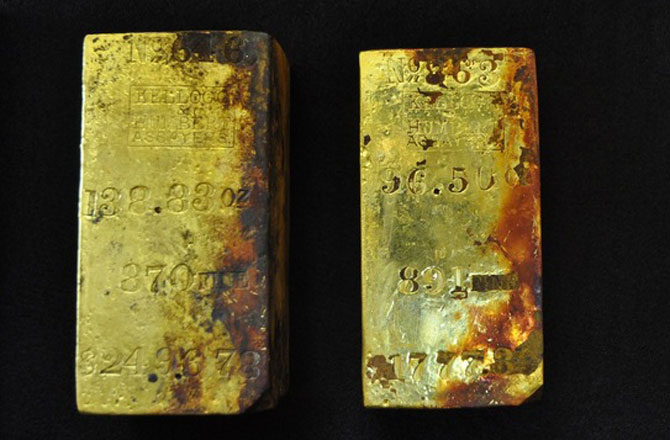A ship that sank in 1857 during the Californian Gold Rush went down with something extraordinary in it. A bar of gold found in the wreckage in 2011 sold for a record of $8 million when it went to auction at Bonhams in Los Angeles, California. The SS Central America was carrying a nearly 14–ton hoard of gold when it went down. Back then its 14- tons of gold was worth nearly two million dollars. The ship was caught up in a hurricane and when the news got out that it sunk, that is when the Panic of 1857 set in. This sinking was actually the world’s first world-wide economic crisis.
If the ship was carrying nearly two million dollars’ worth of gold, where did the rest of the ingots go? Apparently when the wreckage was found in the Atlantic in 1987, much of the hoard was recovered from the seabed. The discovery brought much attention – not because they found a historical site and wreckage, but because many people fought over the ownership of all of that gold. It took nearly nine years of legal battles to bring an end to the confusion – dozens of insurance companies claimed they had paid out for the loss of the ship more than 155 years ago and believed that this pay out meant that they owned the gold. Once the case was settled, nearly 92% of the gold went to the discovery group who found the wreckage. The leader of the group who had found the hoard, Tommy Thompson, was part of a company called Columbus-America Discovery Group.

One ingot to be sold at auction, the Kellog and Humbert ingot, has a stamp on the base of the bar with the name “Kellog and Humbert” and its original value of $743.70. On the other side is a serial number, a repeated “648”. A director of the rare coins department at auctioneers Bonhams, Paul Song said that even though this piece of gold is extremely old, it has a lovely shade of yellow-gold and is still nearly perfect. What makes it fascinating is not only its worth but the fact that the ingot is a large piece of history of America and the Californian Gold Rush.
With the sale of the ingot there will be a certificate of authenticity supplied by the Columbus-America Discovery Group. It will be signed by Tommy Thompson to ensure that it came directly from the wreckage site of the SS Central America.
The gold ship had been making its voyage from the Panamanian port of Colon on September 3, 1857 to New York. It was under the command of William Lewis Herndon and had 578 passengers and crew on board. The ship made a brief stop in Havana and continued north, heading for the United States’ east coast. However, on September 9th the ship was caught in a Category 2 hurricane off the Carolinas. The ship managed to keep afloat for two days after weathering the hurricane, however the sails were shredded to the point where they couldn’t be used anymore. The ship was also taking on water and the boiler was close to being extinguished.

The fate of the ship was decided when the seals to the paddle wheels sprang a leak. On noon that day, the engineers on the ship could no longer keep the boiler’s fire lit. This resulted in a fall of steam pressure that shut down both pumps that were keeping the water at bay and the paddle wheels keeping the ship’s bow to the wind. Then the crew and passengers attempted to hang the ship’s flag upside down in the universal sign of distress, however, no other passing ship came to their rescue. Getting desperate, a bucket brigade was formed and all crew and passengers worked the whole night through to fight against the rising water.
Once the ship was out of the eye of the storm, the crew made feeble attempts at trying to relight the boiler. However, it wouldn’t have done much good anyway as the second half of the storm moved in. Since there was no power, the ship was unable to escape the terrible winds, and the storm carried it off. After once again surviving the night, the SS Central America spotted two ships. 153 passengers, mainly women and children, had managed to make their way to the lifeboats that were launched for them. Sadly, in the intense winds and heavy waves the Central America and the rest of its crew and passengers were swept away without any hope of a rescue. By eight that night, the ship had sunk with the rest of the crew and passengers, along with the cargo.
